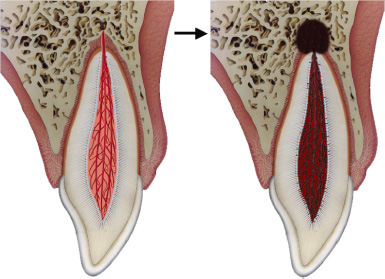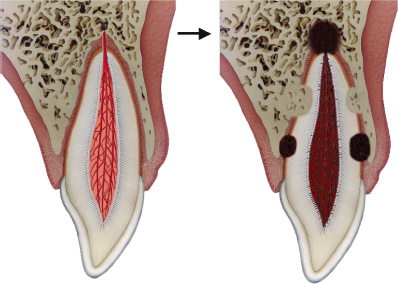Predictors for Healing Complications
OBJECTIVE
1 Understand the relationship between healing complication predictors and the etiology of complications.
2 Recognize the relevance of healing complication predictors in treatment planning.
3 Recognize important predictors for pulp necrosis, root resorption, arrested root development, loss of marginal bone and tooth loss.
4 Recognize the use of predictors in an interactive program on www.dentaltraumaguide.org to assess the risk for individual trauma cases.
PULPAL HEALING AND PULPAL NECROSIS
Two main scenarios are involved in the development of infected pulp necrosis. The first is invasion of bacteria through dentinal tubules or directly to exposed pulpal tissue. The second follows rupture of the neurovascular supply to the pulp through the apical foramen, associated with a leak in the PDL, resulting in subsequent infection of the ischemic pulp.

The strongest healing predictor appears to be dislocation of the tooth in the socket (luxation diagnosis) followed by the size of the apical foramen.211 The larger the diameter, the more likely the chances are for pulpal revascularization. Other predictors shown in the illustration have also been found to have implications.
Predictors for pulp necrosis
- Size of apical foramen
- Luxation with displacement
- Length of pulp tissue (apex to coronal dentin)
- Compression of apical pulpal tissue (intrusion)
- Age
- External contaminants (avulsion)
- Dentin exposure
- Pulpal exposure
- Exactness of repositioning following displacement
PDL HEALING AND ROOT RESORPTION
A minor injury to the PDL, such as isolated rupture of PDL fibers, is generally followed by complete regeneration of the tissue. In more severe dental trauma (e.g. lateral luxation or intrusive luxation), in which tissue damage includes adjacent bony tissue, recruitment of osteoclasts often occurs, leading to resorption of the root surface. The result is repair-related resorption (surface resorption), ankylosis-related resorption or infection-related resorption.

DISTURBED/ARRESTED ROOT DEVELOPMENT
Luxation injuries involving teeth with incomplete root development may cause damage to Hertwig’s epithelial root sheath (HERS), a structure responsible for the morphology and shape of the root.211 Any significant damage to this structure will result in partial or total arrest of further root formation through direct physical dama/>
Stay updated, free dental videos. Join our Telegram channel

VIDEdental - Online dental courses


